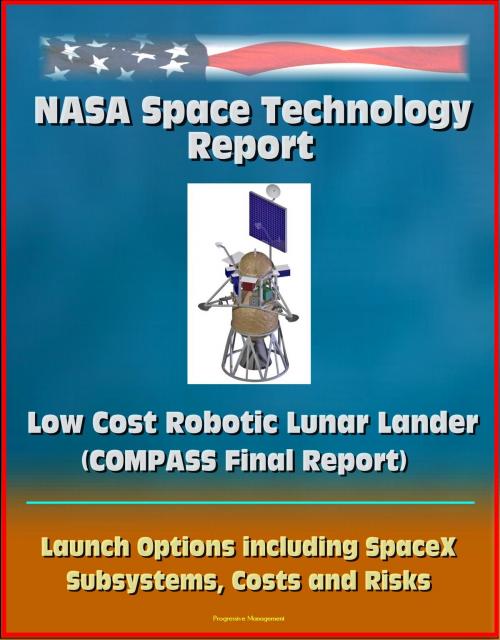NASA Space Technology Report: Low Cost Robotic Lunar Lander (COMPASS Final Report), Launch Options including SpaceX, Subsystems, Costs and Risks
Nonfiction, Science & Nature, Technology, Aeronautics & Astronautics, Science, Physics, Astrophysics & Space Science| Author: | Progressive Management | ISBN: | 9781311953001 |
| Publisher: | Progressive Management | Publication: | September 3, 2014 |
| Imprint: | Smashwords Edition | Language: | English |
| Author: | Progressive Management |
| ISBN: | 9781311953001 |
| Publisher: | Progressive Management |
| Publication: | September 3, 2014 |
| Imprint: | Smashwords Edition |
| Language: | English |
The goal of this COllaborative Modeling for the Parametric Assessment of Space Systems (COMPASS) session was to use Total Low Cost as the objective function, and design a Robotic Lunar Lander to deliver an unspecified payload (greater than zero) to the lunar surface for the lowest cost. The spacecraft designed as the baseline out of this study was a solar powered robotic lander, launched on a Minotaur V launch vehicle on a direct injection trajectory to the lunar surface. A Star 27 solid rocket motor does lunar capture and performs 88 percent of the descent burn. The Robotic Lunar Lander soft-lands using a hydrazine propulsion system to perform the last 10 percent of the landing maneuver, leaving the descent at a near zero, but not exactly zero, terminal velocity. This low-cost robotic lander delivers 10 kg of science payload instruments to the lunar surface.
1.0 Executive Summary * 2.0 Study Background and Assumptions * 2.1 Introduction * 2.2 Assumptions and Approach * 2.2.1 Survey Starting Points * 2.2.2 Fault Tolerance * 2.3 Growth, Contingency and Margin Policy * 2.4 Mission Description * 2.4.1 Mission Analysis Assumptions * 2.4.2 Main Mission Trajectory Options * 2.4.3 Mission Analysis Event Timeline * 2.4.4 Mission Trajectory Details * 2.5 Small Launch Vehicle Details * 2.5.1 Minotaur * 2.5.2 SpaceX—Alternate Launch Vehicle Option * 2.6 System Design Trade Space: Preliminary Analysis * 2.7 Baseline System Design * 3.0 Baseline Design * 3.1 Top Level Design (MEL and PEL) * 3.1.1 Master Equipment List (MEL) * 3.1.2 Power Equipment List (PEL) * 3.2 System Level Summary * 3.3 Design Concept Drawing and Description * 4.0 Subsystem Breakdown * 4.1 Communications * 4.1.1 Communications Requirements * 4.1.2 Communications Assumptions * 4.1.3 Communications Design and MEL * 4.1.4 Communications Trades * 4.1.5 Communications Analytical Methods * 4.1.6 Communications Risk Inputs * 4.1.7 Communications Recommendation * 4.2 Avionics * 4.2.1 Avionics Requirements * 4.2.2 Avionics Assumptions * 4.2.3 Avionics Design and MEL * 4.2.4 Avionics Trades * 4.2.5 Avionics Analytical Methods * 4.2.6 Avionics Risk Inputs * 4.2.7 Avionics Recommendation * 4.3 Electrical Power System * 4.3.1 Electrical Power Requirements * 4.3.2 Electrical Power Assumptions * 4.3.3 Electrical Power Design and MEL * 4.3.4 Electrical Power Trades * 4.3.5 Electrical Power Analytical Methods * 4.3.6 Electrical Power Risk Inputs * 4.3.7 Electrical Power Recommendation * 4.4 Structures and Mechanisms * 4.4.1 Structures and Mechanisms Requirements * 4.4.2 Structures and Mechanisms Assumptions * 4.4.3 Structures and Mechanisms Design and MEL * 4.4.4 Structures and Mechanisms Trades * 4.4.5 Structures and Mechanisms Analytical Methods * 4.4.6 Structures and Mechanisms Risk Inputs * 4.4.7 Structures and Mechanisms Recommendation * 4.5 Propulsion and Propellant Management * 4.5.1 Propulsion and Propellant Management Requirements * 4.5.2 Propulsion and Propellant Management Assumptions * 4.5.3 Propulsion and Propellant Management Analytical Methods * 4.5.4 Propulsion and Propellant Management Design and MEL * 4.5.5 Propulsion and Propellant Management Trades * 4.5.6 Propulsion and Propellant Management Risk Inputs * 4.5.7 Propulsion and Propellant Management Recommendation * 4.6 Thermal Control * 4.6.1 Thermal Requirements * 4.6.2 Thermal Assumptions * 4.6.3 Thermal Design and MEL * 4.6.4 Thermal Trades * 4.6.5 Thermal Analytical Methods * 4.6.6 Thermal Risk Inputs * 4.6.7 Thermal Recommendation * 5.0 Cost, Risk and Reliability * 5.1 Costing: Baseline Chemical Lunar Lander * 5.2 Cost Modeling Assumptions * 5.3 Cost Modeling Approach * 6.0 Trade Space Iterations * 6.1 Case 1: Off-the-Shelf Chemical Propulsion * 6.2 Case 2: Off-the-Shelf Electric Propulsion * 6.3 Case 3: Advanced Direct Drive Electric Propulsion * Appendix A.—Acronyms and Abbreviations * Appendix B.—Case 1 Rendered Design Drawings * Appendix C.—Study Participants * Bibliography
The goal of this COllaborative Modeling for the Parametric Assessment of Space Systems (COMPASS) session was to use Total Low Cost as the objective function, and design a Robotic Lunar Lander to deliver an unspecified payload (greater than zero) to the lunar surface for the lowest cost. The spacecraft designed as the baseline out of this study was a solar powered robotic lander, launched on a Minotaur V launch vehicle on a direct injection trajectory to the lunar surface. A Star 27 solid rocket motor does lunar capture and performs 88 percent of the descent burn. The Robotic Lunar Lander soft-lands using a hydrazine propulsion system to perform the last 10 percent of the landing maneuver, leaving the descent at a near zero, but not exactly zero, terminal velocity. This low-cost robotic lander delivers 10 kg of science payload instruments to the lunar surface.
1.0 Executive Summary * 2.0 Study Background and Assumptions * 2.1 Introduction * 2.2 Assumptions and Approach * 2.2.1 Survey Starting Points * 2.2.2 Fault Tolerance * 2.3 Growth, Contingency and Margin Policy * 2.4 Mission Description * 2.4.1 Mission Analysis Assumptions * 2.4.2 Main Mission Trajectory Options * 2.4.3 Mission Analysis Event Timeline * 2.4.4 Mission Trajectory Details * 2.5 Small Launch Vehicle Details * 2.5.1 Minotaur * 2.5.2 SpaceX—Alternate Launch Vehicle Option * 2.6 System Design Trade Space: Preliminary Analysis * 2.7 Baseline System Design * 3.0 Baseline Design * 3.1 Top Level Design (MEL and PEL) * 3.1.1 Master Equipment List (MEL) * 3.1.2 Power Equipment List (PEL) * 3.2 System Level Summary * 3.3 Design Concept Drawing and Description * 4.0 Subsystem Breakdown * 4.1 Communications * 4.1.1 Communications Requirements * 4.1.2 Communications Assumptions * 4.1.3 Communications Design and MEL * 4.1.4 Communications Trades * 4.1.5 Communications Analytical Methods * 4.1.6 Communications Risk Inputs * 4.1.7 Communications Recommendation * 4.2 Avionics * 4.2.1 Avionics Requirements * 4.2.2 Avionics Assumptions * 4.2.3 Avionics Design and MEL * 4.2.4 Avionics Trades * 4.2.5 Avionics Analytical Methods * 4.2.6 Avionics Risk Inputs * 4.2.7 Avionics Recommendation * 4.3 Electrical Power System * 4.3.1 Electrical Power Requirements * 4.3.2 Electrical Power Assumptions * 4.3.3 Electrical Power Design and MEL * 4.3.4 Electrical Power Trades * 4.3.5 Electrical Power Analytical Methods * 4.3.6 Electrical Power Risk Inputs * 4.3.7 Electrical Power Recommendation * 4.4 Structures and Mechanisms * 4.4.1 Structures and Mechanisms Requirements * 4.4.2 Structures and Mechanisms Assumptions * 4.4.3 Structures and Mechanisms Design and MEL * 4.4.4 Structures and Mechanisms Trades * 4.4.5 Structures and Mechanisms Analytical Methods * 4.4.6 Structures and Mechanisms Risk Inputs * 4.4.7 Structures and Mechanisms Recommendation * 4.5 Propulsion and Propellant Management * 4.5.1 Propulsion and Propellant Management Requirements * 4.5.2 Propulsion and Propellant Management Assumptions * 4.5.3 Propulsion and Propellant Management Analytical Methods * 4.5.4 Propulsion and Propellant Management Design and MEL * 4.5.5 Propulsion and Propellant Management Trades * 4.5.6 Propulsion and Propellant Management Risk Inputs * 4.5.7 Propulsion and Propellant Management Recommendation * 4.6 Thermal Control * 4.6.1 Thermal Requirements * 4.6.2 Thermal Assumptions * 4.6.3 Thermal Design and MEL * 4.6.4 Thermal Trades * 4.6.5 Thermal Analytical Methods * 4.6.6 Thermal Risk Inputs * 4.6.7 Thermal Recommendation * 5.0 Cost, Risk and Reliability * 5.1 Costing: Baseline Chemical Lunar Lander * 5.2 Cost Modeling Assumptions * 5.3 Cost Modeling Approach * 6.0 Trade Space Iterations * 6.1 Case 1: Off-the-Shelf Chemical Propulsion * 6.2 Case 2: Off-the-Shelf Electric Propulsion * 6.3 Case 3: Advanced Direct Drive Electric Propulsion * Appendix A.—Acronyms and Abbreviations * Appendix B.—Case 1 Rendered Design Drawings * Appendix C.—Study Participants * Bibliography















